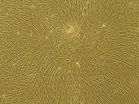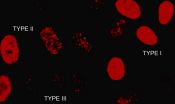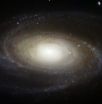HOUSTON, TX, February 28, 2014 (Press-News.org) Astronauts floating weightlessly in the International Space Station may appear carefree, but years of research have shown that microgravity causes changes to the human body. Spaceflight also means exposure to more radiation. Together, microgravity and radiation exposure add up to pose serious health risks. But research is not only making space safer for astronauts, it's helping to improve health care for the Earth-bound as well.
One of the effects of space radiation is damage to DNA, or deoxyribonucleic acid, the genetic material in nearly every cell of our bodies. When damaged DNA repairs itself, errors can occur that increase the risk of developing cancer. A new study, MicroRNA Expression Profiles in Cultured Human Fibroblast in Space - Micro-7 for short - will examine the effect of gravity on DNA damage and repair. Because there is no controlled radiation source aboard the space station, the cells will be treated with bleomycin, a chemotherapy drug, to induce DNA damage.
"When a cell in the human body is exposed to radiation, DNA will be broken and repaired, which is considered the initiation stage of tumor development," explains principal investigator Honglu Wu, Ph.D., at NASA's Johnson Space Center in Houston. "Cells damaged from radiation exposure in space also experience microgravity, which we know changes gene expressions even without radiation exposure." That equals the space double-whammy for the human body.
Previous studies have exposed cells or organisms on Earth to high-energy charged particles to simulate space radiation, using the resulting cell damage or induction of tumors to predict the risk of cancer for astronauts from radiation. But those predictions don't include the effects of microgravity, making them potentially less accurate than the space based Micro-7 study. This investigation will address that by examining the effects of bleomycin-induced DNA damage aboard the orbiting laboratory.
The study will be the first in space to use cultured human fibroblasts, the non-dividing cells that make up most of the human body. Fibroblasts form the framework for organs and tissues and play a critical role in wound healing and other bodily functions.
The investigation is scheduled to launch to the orbital complex aboard SpaceX-3 March 16, 2014. Micro-7 is managed by NASA's Ames Research Center, Moffett Field, Calif., and is funded by NASA's Space Biology Program. Bioserve Space Technologies at the University of Colorado, Boulder, Colo. is providing the experiment hardware and implementing the science payload aboard the space station.
Wu will focus on how these cells respond to DNA damage in space by examining changes in a small, non-coding form of RNA known as microRNA, which is known to affect how genes are expressed in cells. The investigation will compare the cells in spaceflight with those on the ground to identify unknown functions of microRNA and the functions they regulate in our bodies. Similarities and differences in the space and Earth data will also improve our knowledge of fundamental biological processes critical for maintaining normal cell function.
In the future, Wu would like to have a controlled radiation source, such as a portable X-ray machine, on the space station to expose cultured cells or small animals to specific doses of radiation in space. Cells or organisms on the ground would be exposed to the same dose, and the DNA repair in both compared. Wu says that may be possible in the near future, perhaps by modifying a bone density scanner or other equipment aboard the space station.
Researchers can use data from Micro-7 in future Earth-based studies to examine whether the cell changes observed during spaceflight are seen in disease states of tissues and organs as well. Ultimately, this may help scientists better understand disease and this type of research could even lead to development of new treatment drugs.
"If we learn more about how cells repair DNA damage more efficiently or less efficiently in space, that knowledge also will be helpful for cancer radiotherapy or treatment with radiation," Wu adds. "A challenge in medical treatment is that certain tumors are highly resistant to radiation. But there could be various ways to make them more radiosensitive, or less resistant to radiation. That would help provide more effective treatment." And also make those weightless astronauts a bit more carefree.
Melissa Gaskill
International Space Station Program Science Office
NASA's Johnson Space Center
The Space Double-Whammy: Less Gravity, More Radiation
A new study, MicroRNA Expression Profiles in Cultured Human Fibroblast in Space - Micro-7 for short - will examine the effect of gravity on DNA damage and repair.
2014-02-28
ELSE PRESS RELEASES FROM THIS DATE:
Feynman's lecture brought to life in science doodle
2014-02-28
In this month's edition of Physics World, professional "science doodler" Perrin Ireland gives her unique take on one of Richard Feynman's famous lectures, 50 years after it was first delivered.
The doodle is made up of an array of small, colourful, cartoon-like pictures that merge into one big collage representing Feynman's "The Great Conservation Principles" lecture that he gave at Cornell University in 1964 – one of the first of Feynman's lectures to be captured on film.
The doodle, which was commissioned as part of Physics World's special issue on education, includes ...
Nobelist James Watson proposes an unconventional view of type 2 diabetes causation
2014-02-28
Cold Spring Harbor, NY – At 85, Nobel laureate James D. Watson, the co-discoverer of the double-helix structure of DNA, continues to advance intriguing scientific ideas. His latest, a hypothesis on the causation of type 2 diabetes, is to appear 7 pm Thursday US time in the online pages of The Lancet, the prestigious British medical journal.
Watson's hypothesis, which is featured as the Lancet cover story in the U.S. print edition dated March 1-7, 2014, suggests that diabetes, dementias, cardiovascular disease, and some cancers are linked to a failure to generate sufficient ...
High-calorie feeding may slow progression of ALS
2014-02-28
Increasing the number of calories consumed by patients with amyotrophic lateral sclerosis (ALS) may be a relatively simple way of extending their survival. A phase 2 clinical trial led by Massachusetts General Hospital (MGH) physicians found that ALS patients receiving a high-calorie, high-carbohydrate tube-feeding formula lived longer with fewer adverse events than participants who received a standard formula designed maintain their weight. While the small size of the trial indicates results need to be interpreted with caution, the authors are optimistic that improved ...
Why and how anti-retroviral therapy works even against HIV cell-to-cell transmission
2014-02-28
The discovery of direct cell-to-cell transmission of HIV, and the finding that some anti-HIV drugs don't seem active against virus that spreads that way, have caused questions and concern. A study published on February 27th in PLOS Pathogens tested a panel of anti-HIV drugs for their ability to suppress cell-to-cell transmission of the virus. The results reveal differences between different drugs, explain why and how anti-retroviral therapy (ART) does work, and have implications for the prevention of drug resistance as well as the development of new effective anti-HIV drugs. ...
Early atherosclerotic plaques regress when cholesterol levels are lowered
2014-02-28
Early but not advanced forms of atherosclerotic plaques in the vessel wall disappear when the levels of 'bad' cholesterol are lowered, according to a study in mice from Karolinska Institutet, Sweden. The findings, published in PLoS Genetics, indicate that preventative cholesterol-lowering treatment could prevent more advanced, clinically relevant plaque to develop.
Almost half of all deaths worldwide are caused by strokes and heart attacks. The main underlying cause is atherosclerosis, where fat accumulates in the blood vessel walls in the so-called plaques. Atherosclerosis ...
BUSM Study discovers novel therapeutic targets for Huntington's disease
2014-02-28
(Boston) – A study led by researchers at Boston University School of Medicine (BUSM) provides novel insight into the impact that genes may have on Huntington's disease (HD). The study, published online in PLOS Genetics, identified specific small segments of RNA (called micro RNA or miRNA) encoded in DNA in the human genome that are highly expressed in HD. Micro RNAs are important because they regulate the expression of genes. The researchers showed that these miRNAs are present in higher quantities in patients with HD and may act as a mitigating factor in the neurologic ...
Do obesity, birth control pills raise risk of multiple sclerosis?
2014-02-27
PHILADELPHIA – The role of the so-called "obesity hormone" leptin and hormones used for birth control in the development of multiple sclerosis (MS) is examined in two new studies released today that will be presented at the American Academy of Neurology's 66th Annual Meeting in Philadelphia, April 26 to May 3, 2014.
For the obesity study, BMI was calculated for 210 people with MS and 210 people of the same age and sex who did not have MS at ages 15 and 20 and at the time of the study. The study found that people who are obese at age 20 are twice as likely to later develop ...
Color of passion: Orange underbellies of female lizards signal fertility
2014-02-27
Australian lizards are attracted to females with the brightest orange patches – but preferably not too large – on their underbelly, according to research published in the open-access journal Frontiers in Ecology and Evolution.
Lake Eyre dragon lizards, Ctenophorus maculosus, are found exclusively in salt deserts in southern Australia, where they feed on dead insects blown onto the salt crust. When females become fertile they develop bright orange patches on their normally pale underbelly and change their behavior towards males: instead of "waving them away" with their ...
Early strokes leave many young adults with long-lasting disability
2014-02-27
One-third of people who survive a stroke before age 50 are unable to live independently or need assistance with daily activities 10 years after their stroke, according to research in the American Heart Association journal Stroke.
About 10 percent of strokes occur in 18- and 50-year-olds.
"Even if patients seem relatively well recovered with respect to motor function, there may still be immense 'invisible' damage that leads to loss of independence," said Frank-Erik de Leeuw, Ph.D., senior author of the study and associate professor of neurology at the Radboud University ...
Fat or flat: Getting galaxies into shape
2014-02-27
Australian astronomers have discovered what makes some spiral galaxies fat and bulging while others are flat discs — and it's all about how fast they spin.
The research, led by the International Centre for Radio Astronomy Research (ICRAR) in Perth, found that fast-rotating spiral galaxies are flat and thin while equally sized galaxies that rotate slowly are fatter.
The study was published today in the prestigious Astrophysical Journal and was part of "The Evolving Universe" research theme of the ARC Centre of Excellence for All-sky Astrophysics (CAASTRO).
ICRAR Research ...
LAST 30 PRESS RELEASES:
First Editorial of 2026: Resisting AI slop
Joint ground- and space-based observations reveal Saturn-mass rogue planet
Inheritable genetic variant offers protection against blood cancer risk and progression
Pigs settled Pacific islands alongside early human voyagers
A Coral reef’s daily pulse reshapes microbes in surrounding waters
EAST Tokamak experiments exceed plasma density limit, offering new approach to fusion ignition
Groundbreaking discovery reveals Africa’s oldest cremation pyre and complex ritual practices
First breathing ‘lung-on-chip’ developed using genetically identical cells
How people moved pigs across the Pacific
Interaction of climate change and human activity and its impact on plant diversity in Qinghai-Tibet plateau
From addressing uncertainty to national strategy: an interpretation of Professor Lim Siong Guan’s views
Clinical trials on AI language model use in digestive healthcare
Scientists improve robotic visual–inertial trajectory localization accuracy using cross-modal interaction and selection techniques
Correlation between cancer cachexia and immune-related adverse events in HCC
Human adipose tissue: a new source for functional organoids
Metro lines double as freight highways during off-peak hours, Beijing study shows
Biomedical functions and applications of nanomaterials in tumor diagnosis and treatment: perspectives from ophthalmic oncology
3D imaging unveils how passivation improves perovskite solar cell performance
Enriching framework Al sites in 8-membered rings of Cu-SSZ-39 zeolite to enhance low-temperature ammonia selective catalytic reduction performance
AI-powered RNA drug development: a new frontier in therapeutics
Decoupling the HOR enhancement on PtRu: Dynamically matching interfacial water to reaction coordinates
Sulfur isn’t poisonous when it synergistically acts with phosphine in olefins hydroformylation
URI researchers uncover molecular mechanisms behind speciation in corals
Chitin based carbon aerogel offers a cleaner way to store thermal energy
Tracing hidden sources of nitrate pollution in rapidly changing rural urban landscapes
Viruses on plastic pollution may quietly accelerate the spread of antibiotic resistance
Three UH Rainbow Babies & Children’s faculty elected to prestigious American Pediatric Society
Tunnel resilience models unveiled to aid post-earthquake recovery
Satellite communication systems: the future of 5G/6G connectivity
Space computing power networks: a new frontier for satellite technologies
[Press-News.org] The Space Double-Whammy: Less Gravity, More RadiationA new study, MicroRNA Expression Profiles in Cultured Human Fibroblast in Space - Micro-7 for short - will examine the effect of gravity on DNA damage and repair.




